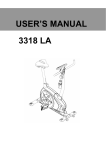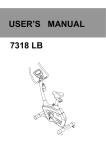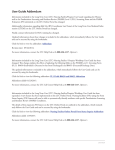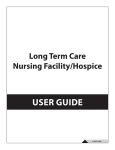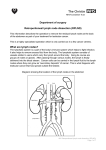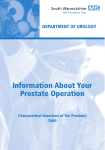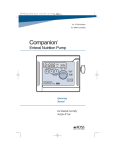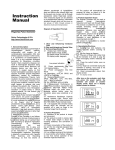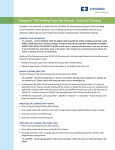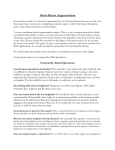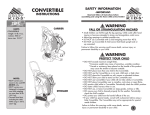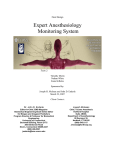Download Preoperative Instructions for Breast Reduction
Transcript
Preoperative Instructions for Breast Reduction Preoperative 1. A preoperative appointment will be scheduled one to two weeks prior to your day of surgery. This appointment will not be made until your surgery has been authorized by your insurance company. At this appointment, your medical history, specifically your list of medications and herbal supplements, will be reviewed. Two weeks prior to surgery, all herbal supplements, Vitamin E, and aspirin or ibuprofen containing products should be discontinued to decrease bleeding and subsequent bruising. Depending on your age, preexisting medical problems, and facility where your surgery is scheduled you will be sent for blood work, and possibly an EKG. In addition, you may be asked to obtain formal medical clearance from your family doctor/internist, or an appointment may be set up at Shands to undergo preadmission testing (PAT) at which point an anesthesiologist will review your medical history and order additional tests if warranted to safely clear you to undergo general anesthesia. 2. You must quit smoking at least 3 weeks prior to surgery. Your surgery will be cancelled if you continue to smoke as smoking increases your chances of respiratory problems and wound healing problems. This is an elective procedure, with multiple incisions that will not heal, resulting in a poor cosmetic outcome and long term wound care if you continue to smoke! 3. The week of surgery, wash daily with an antimicrobial soap to decrease your chances of infection. In addition, at your preoperative appointment you will be given a Hibiclens scrub brush that you should use the morning of surgery. If you have an active rash or infection, your surgery will be delayed until it is resolved. 4. Do not drink or eat anything after midnight the day prior to your surgery to minimize the risk of aspiration or other anesthetic related problems. This includes water, coffee, gum, mints, etc. The anesthesiologist will cancel your surgery if you eat or drink anything after midnight. 5. Bring a list of your medications and herbal supplements the morning of surgery for review with your anesthesiologist. If you have a history of breathing problems, bring your inhaler to the surgery center. 6. Do not wear contact lenses to the surgery center/hospital. Bring a case for your glasses. Day of Surgery 1. Please arrive at the surgery center 2 hours prior to the surgical start time. During this time you will complete paperwork, change into a surgical gown, receive intravenous fluids and preoperative medications, and women of child bearing age will be given a urine pregnancy test. You will have an opportunity to review any questions with Dr Ranieri and the anesthesiologist. In addition, Dr Ranieri will perform a series of preoperative markings. 2. You must have a responsible adult available to drive you home after surgery and stay with you for at least the first 48‐72 hours after surgery. If you have young children, you need to arrange for childcare. Keep in mind that you will be prohibited from picking up your child for 3‐4 weeks after surgery, and appropriate assistance should be set up before surgery. This is related to wound edge separation and prolonged wound healing which results from any lifting, pulling, and pushing in the immediate postoperative period. 3. Please leave all valuables at home, including body‐piercing jewelry. Metal will conduct electrical currents and may lead to burns. 4. To reduce infection, do not wear makeup, lotions, or deodorant on the operative area. 5. To simplify anesthetic monitoring, do not wear nail polish on either hand. 6. You will stay in the recovery area for approximately 1‐2 hours. Typically, it takes this amount of time until your pain is well controlled, you are alert, and you can drink without being nauseated. A Foley catheter will be placed prior to surgery (once you are asleep) to monitor your fluid status. This will be removed before you are awakened from anesthesia. You must urinate spontaneously prior to release to ensure no problems with urination once you are released. Postoperative Week 1 1. Your activities will be restricted in order to minimize bleeding, swelling, and separation of your incisions that can result in unfavorable scarring. Swelling may increase the first 48 hours before it starts to diminish. a. Do not lie on your stomach, either side, or on your drains after surgery. Lay in a recliner or keep your chest/head elevated on pillows. b. Do not push, pull, lift, climb, reach over your head or do any strenuous activities, as this will elevate your blood pressure which may increase bleeding/bruising. In addition, these activities will lead to wound separation and prolong your recovery time secondary to wound healing problems. c. You may apply towel‐padded ice packs over your dressing for limited periods (15 minute intervals only) for comfort and to minimize swelling. d. Do not drive until you are not taking narcotic pain medication, and you are cleared by Dr Ranieri. e. Walk around the house every hour while awake to help maintain your circulation ( to minimize your chance of a blood clot) starting the day of surgery. Be careful when you change positions the first week, as you may experience mild dizziness or lightheadedness. f. Wear UV protection (SPF 30 or greater) to protect your incisions from burns and hyperpigmentation. Avoid lengthy sun exposure. 2. You may resume your preoperative diet as tolerated. Start with clear liquids, advance to full liquids, and then regular food as your nausea resolves and bowel movements become more regular. No alcohol, salt, or soy sauce the first week to minimize swelling. Stay well hydrated. Do not let nausea progress to vomiting. Take over‐the‐counter stool softeners to prevent narcotic/anesthetic associated constipation. No smoking. 3. You may resume your preoperative medications, with the exception of blood‐thinners, aspirin or ibuprofen containing products, herbal supplements, and Vitamin E to avoid prolonged bruising. Complete your course of antibiotics (note that antibiotics may impair birth control pills). Take your pain medication as prescribed, typically 1‐2 tablets every 4‐6 hours as needed. It is recommended that you take the minimal amount of narcotic pain medication necessary to relieve your pain, and transition to Extra‐ Strength Tylenol as soon as possible after your surgery to minimize narcotic associated side effects (often worse than the pain related to the surgery). 4. You may remove your dressings and shower 48 hours after your surgery. Remove your surgical bra while in a lying position, after 5 minutes sit up. If you are not dizzy, you may stand with assistance and walk to the shower. Do not use hot water as this may cause dizziness as your blood vessels dilate in response to the warmth. Keep your back to the showerhead and do not rub your incisions. You may wash your hair with care to avoid rundown of the shampoo onto your incisions. Pat your incisions dry lightly and replace your surgical bra, dressings and gauze. Thick padded cotton (ie sanitary napkins) may be substituted for medical gauze and provide protection from your incisions being irritated from the surgical bra. Do not apply lotions over the incisions. 5. Your first postoperative visit should be scheduled within the first week after your surgery. This appointment should be scheduled by my office staff on the day of your preoperative appointment. As previously mentioned, bring a record of your drain output to this appointment to determine if your drains may be removed. 6. Problems or questions concerning drains should be addressed to the office during regular hours. The only concern related to the drains that would necessitate a call to the office after hours is drainage greater than 50 mL/hr, or significant bleeding. All other concerns, including burning at the drain site (normal), and leaking around the drain (often means the drain is clogged) can be addressed by the office staff during regular hours. Postoperative Weeks 2‐6 Most patients are able to return to work in 3‐4 weeks after their surgery, at least part time or with restrictions. You may resume long leisurely walks and increase non‐strenous activity gradually. You should continue to avoid lifting, pulling, pushing, or reaching above your head for 3‐4 weeks or until all incisions are healed. This includes picking up children! Aerobic activity and upper body exercise may be resumed at 6 weeks if there have been no would healing problems. Lower body exercises may be resumed with restriction in 3 weeks. You should wear your surgical bra for 4 weeks after your surgery, or until all incisions are healed and there has been return of normal sensation underneath your breasts. At this point, there are no restrictions regarding the specific bra you must wear (you may go bra shopping and buy the bra you always wanted to fit into). All swelling will not subside for six months (wearing a bra will help this occur faster), at which point your final result will be evident. Avoid direct or indirect sun exposure to the operative site to minimize pigment changes that may become permanent. This instruction sheet is written to answer most common questions regarding breast reduction surgery. If any addition questions arise, or postoperative problems occur that are not detailed above, please do not hesitate to call the office during regular hours or the answering service after hours at (904) 633‐0130.





